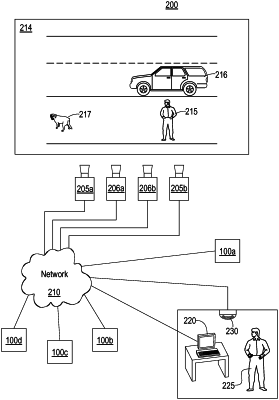| CPC H04N 7/18 (2013.01) | 20 Claims |

|
1. A computer system for identifying an activity, event, or chain of events in a video system, the computer system comprising:
a computer containing a plurality of software modules,
a video stream input, and
wherein the plurality of software modules include
a video capturing module;
an object tracking module;
a track identification module;
a periodic motion tracking module;
a periodic motion identifying module; and
a reasoning module;
wherein
the video capturing module receives images from a video stream and outputs image data directly to both the object tracking module and the periodic motion tracking module;
the object tracking module receives the image data from the video capturing module and produces a tracked path of an object in the video stream based on the image data; and
the track identification module receives the tracked path from the object tracking module and performs a comparison of the tracked path to a model;
the periodic motion tracking module receives the image data from the video capturing module and creates and outputs a data structure representing motion;
the periodic motion identifying module identifies periodic motion and non-periodic motion within the image data based on the output from the periodic motion tracking module; and
the reasoning module receives both the comparison from the track identification module and data regarding the identification of periodic motion and non-periodic motion from the periodic motion identifying module, and based thereon the reasoning module identifies motion characteristics of the activity, event, or chain of events.
|